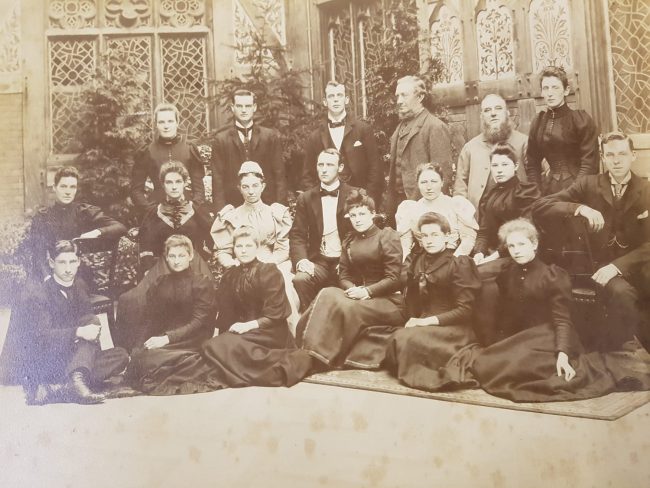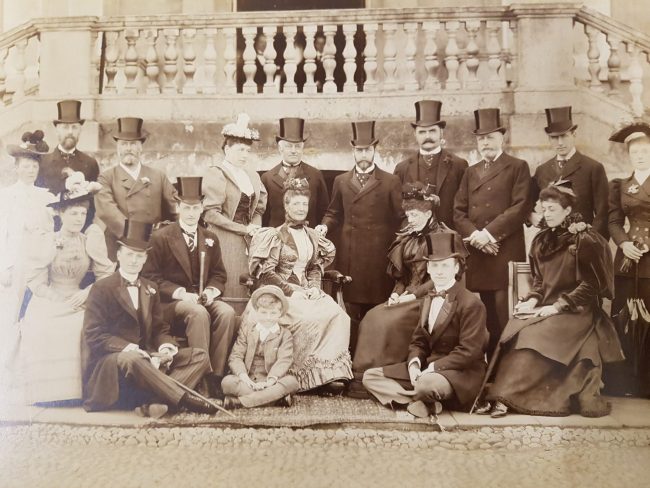Upstairs and Downstairs Exhibition now on at The Hive
- 17th November 2017
Worcestershire Archive Service has just launched a new exhibition on Level Two at The Hive which explores the lives and expectations of those who were servants and those who were masters. It also looks at the interactions between the two groups whose lives were interconnected and dependent on each other.
The Ideal Servant
In an uncatalogued travel journal containing images from pamphlets and postcards from the early 1860s we find a poem and painting from Winchester College of the allegorical servant which illustrates the ideal qualities of a servant. (Item reference: Backlog/BA16106)
A piece of Antiquity: Painted adjoining to the kitchen of Winchester College
A Trusty servants portrait would you see
This emblematic figure well survey
The porker’s snout not nice in diet shews
The padlock shut no secrets he’ll disclose
Patient the ass his master’s wrath will hear
Swiftness in errant the stag’s feet declare;
Loaded his left hand apt to labour saith
The vest his neatness open hand his faith
Girt with his sword his shield upon his arm
Himself and master he’ll protect from harm
This journal is not on display but can be viewed with 7 days’ notice in our originals area.
A test of this ideal can be seen in a pamphlet in this exhibition which contains an account of the divorce trial of Lord Foley and Lady Ann Foley in the 1780s, which centred around Lady Ann’s infidelity with the Earl of Peterborough. The role of the servant in this case is not that of secret keeper for their mistress but as protector of their master’s honour. The coachman and other servants describe the compromising positions they witnessed Lady Foley in, both in carriages and the gardens during her affair. (Item reference: 345.42025 Palfrey Collection)

Image of servants at Madresfield Court Inner Courtyard (De La Hey Chads Corbett) , 1885. (Item reference: WPS 64705)
The Servant’s Role
Clearly defined roles were important for the smooth running of the household. At Northwick Park in the 19th century agreements were made with each servant, so they knew what was expected of them. Some of the agreements have the signature or sign of those servants who were agreeing to them with the page being used as a template for several different employees. Alongside their individual roles servants were expected to follow the rules of the house. This helped preserve their moral character as well as ensure that the household ran smoothly. (Item reference: 705:066/BA4221/23).
Before a servant could be employed they needed to apply for positions which might be advertised in the newspaper or through an employment agency. Some servants were also recommended by other servants or by their current or previous masters who sent letters on their behalf. Unemployed servants or those looking for a new position might even advertise themselves to find employment. Documents relating to this process can be found on display.
When a servant was employed references for both their experience and character were sent for and their conduct outside their work was considered as important as their work itself. The rules of a servant were designed to preserve the moral standing of servants, particularly female ones. The servant was a representative of their master and their moral propriety was of upmost importance while wearing their master’s livery.
One such letter of reference for a servant at Northwick Park lists the good qualities of W. Hopkins who was the new under butler in 1870. This letter however also comments on his sitting up and playing cards at night as a potential problem, which Baron Northwick should be aware of. It describes how Hopkins needs firm discipline and to be worked hard by his superiors to ensure he becomes an ideal servant. (Item reference: 705:066/BA4221/35).
Upstairs
The master of the servant could come from a broad spectrum of society ranging from the middleclass household, to trades and shops and through to the nobility. As an extreme contrast however to the work of the servant, and as many of these documents came from the collections of the landed gentry, the lifestyle of upstairs in this exhibition is one of the wealthier levels of society who kept servants; those who perhaps did not need to work and may have been prominent figures in the local and national community.
The public and private persona of the Upper Classes was an important distinction for those in high profile positions such as in Parliament or in local positions of authority such as Justices of the Peace. A letter in this exhibition from George William Coventry, the new Viscount Deerhurst, (later the 8th Earl) to his father the new 7th Earl, describes the value of these two differing personas on the death of his Grandfather, the 6th Earl, in 1809. The importance of maintaining a good public image was part of holding the title. The recent change in his role is clearly emphasised by the signature which shows him begin to write his name, cross it out and put his new title instead. (Item reference: 705:073/BA14450/290/6).
A pamphlet on display shows the festivities of coming of age the Rt, Hon. the Earl Beachamp (7th Earl Beachamp) as an important event for the whole community. This text is reprinted from the Worcestershire Herald of 5th August 1893 a full itinerary for the celebration which took place between the 1st and 4th August 1893 and included presentations from locals, tenants and employees; dinners; a Garden Party; a House party; a County Ball and a Servant’s Ball at which Earl Beachamp danced with Mrs Weeke the Housekeeper and Lady Mary Lygon with Mr Lovel the House Steward and various others danced with the servants. (Item reference: 705:099/BA3317/2(i)).

Image of the Coventry family at Croome Court on the occasion of the visit of the Duke of York (centre right), 1894. (Item reference: b705:73 BA14450/278/2).
Relationships
How masters and servants got on, and how servants interacted with each other was important for the smooth running of the household. However, like all people who live near each other, issues and tensions could arise both between the servants and between the master and the servants.
The servant was often a valuable member of the household and was trusted with the personal details of their master’s life. As a result there was often a close relationship between master and servant, especially those that had served for a long time.
A bundle of letters in the Northwick Park collection from the long serving House Steward, Louis Mayland, to Baron Northwick (John Rushout 1770-1859) details the lives of those at Northwick while the master was away. The sheer scope of responsibility and trust placed on Mayland is emphasised in this letter as he describes the major building works going on in the house and the progress of the workmen. This work was perhaps the creation of a gallery to house Baron Northwick’s collection of artwork. Alongside the building work and discussing the delivery of art work, the progress of the hay making is mentioned as is mediating the relationships of his fellow servants. Mayland was Lord Northwick’s eyes and ears into the goings on at Northwick Park particularly when he was away a Connaught Place in London. 705:066/BA4221/5(iii)
A travel journal in this exhibition is a heart-breaking example of how important servants could become to both their masters and the colleagues they lived with. The Porter sisters, Anne and Phoebe of ‘The Mansion’ in Birlingham regularly travelled around Britain and the continent taking with them a couple of servants. For several years they took their butler, Brookes, and maid, Goodyear, with them. On one such journey in 1857 however John Brookes, their butler, became sick and passed away whilst in France. Their journal describes how they sat with him as he died and the grief felt by both the sisters and their maid who was close to him and who they comforted. Looking on the 1851 census John would have only been about 34 years old when he died and had served them for 18 years, which is perhaps why his death had such an impact on everyone as he would have grown up through the ranks of servants to become butler. (Item reference: 705:262/BA3940/64).
Sometimes however that relationship did go wrong, servants who lived and worked together might become friends but might also clash in personality and cause tensions downstairs. Likewise the treatment of servants by their masters could be poor.
One document from the Midsummer Quarter Sessions in 1756 relates to an employer who turned away his female servant when she contracted smallpox. Highlighting, that masters did have social, legal and moral obligations to their servants, which William Price broke endangering both Sarah Brinton and others who may have contracted the illness from her by casting her out. (Item reference: 110/BA1/385/13).
The proximity between master and servants living together could blur the boundaries between working and personal relationships. The power held over servants made them vulnerable to being used and cast aside. In this case from 1692 Elisabeth Morris is trying to find someone to support her and her child when a relationship with her master has ended in pregnancy. (Item reference: 110/BA1/164/14-15).
Just as all masters were not kind not all servants were honest, and living in their master’s homes gave them access to their property. As a result some servants broke their master’s trust by stealing from them. In a Quarter sessions case from Midsummer 1752 William Russon of Stoke Prior realised that a silk handkerchief, a flaxan shirt, a pair of shoes and a pair of white metal buckles were missing from his house after John Jones, a servant, had left his service. Jones was later apprehended with the shirt shoes and buckles on him and voluntarily confessed. (Item reference: 110/BA1/369/42).
When discipline breaks down and rules are broken by the servants, masters can be taken advantage of and other servants can struggle to maintain order. A series of letters from Mrs C. Guppy, the cook at Hanley Court, Hanley William to her Master Colonel James Wakeman Newport-Charlett in 1833/34 paint a picture of a breakdown of order and the consequences of it both for the master and the servant. The maids appear to be entertaining men, not doing their work properly and doing whatever they like because the master is absent. The staff are described as helping themselves to the supplies of the house and going as far as allowing access to locals, who are taking milk without paying. (Item reference: 705:146/BA7565/iii).
The experience of the unique relationship between master and servant is not one that we find in the archive very often, especially through the voice of the servant, however; this exhibition aims to find the hidden voice of the servant in the archive and highlight the importance of the servant in the lives of the elites.
Post a Comment